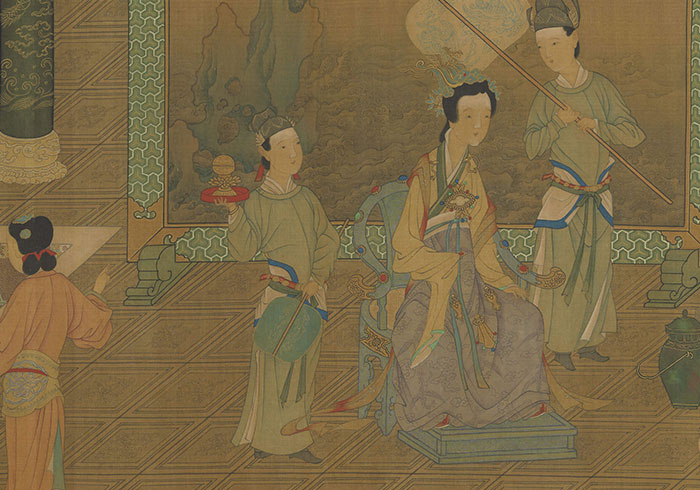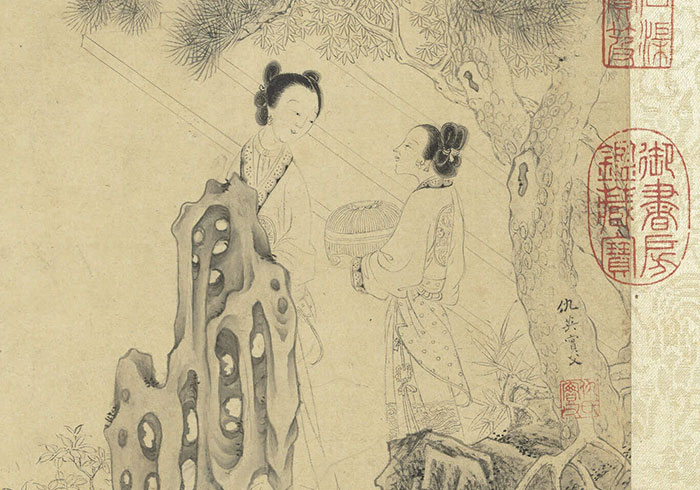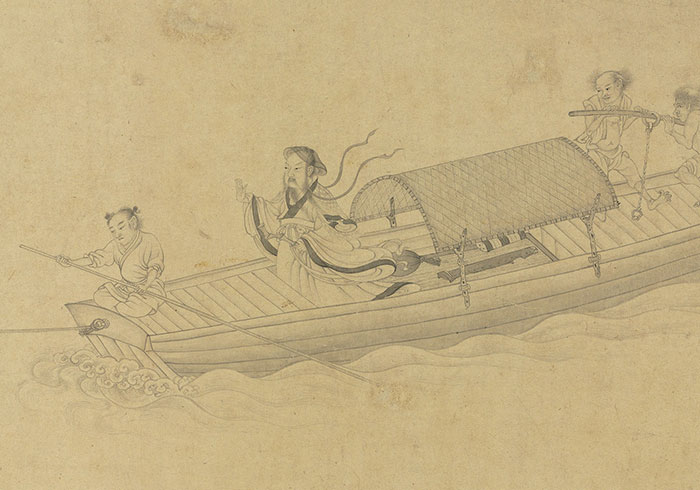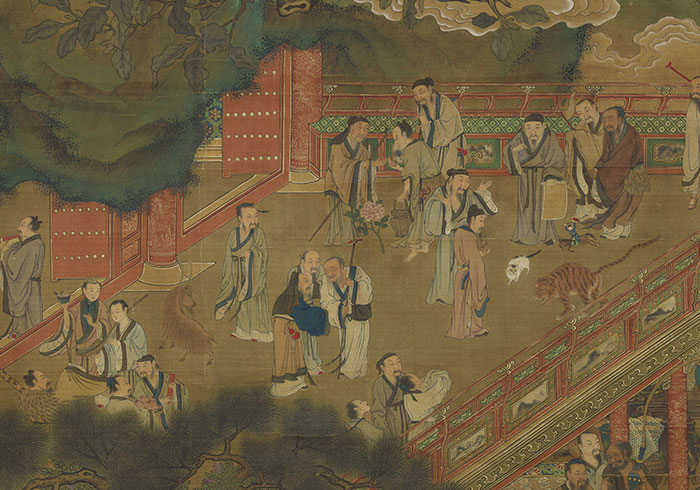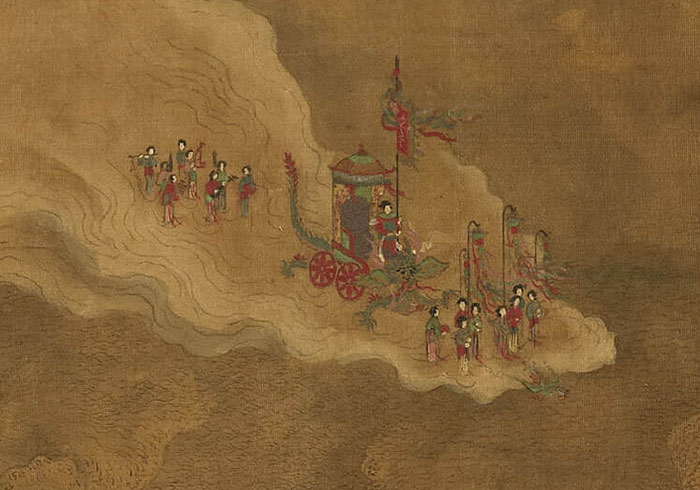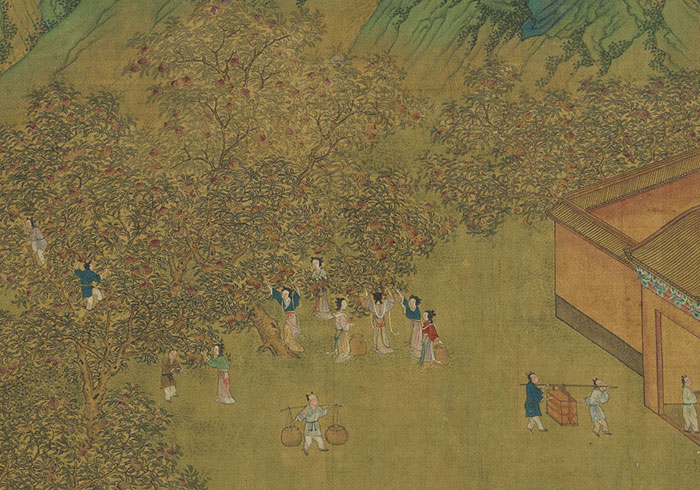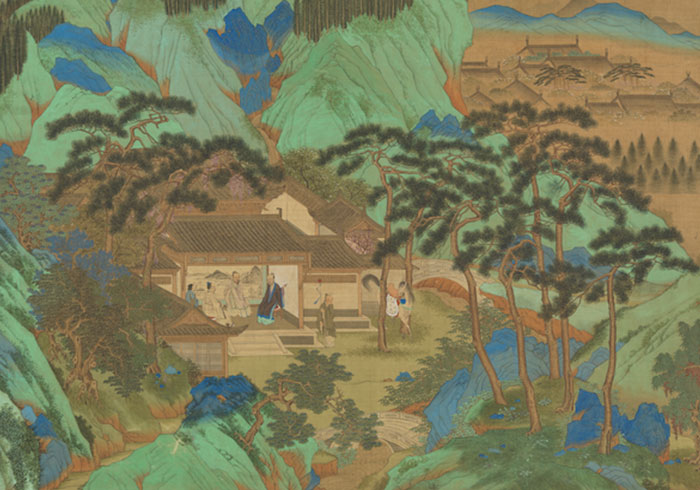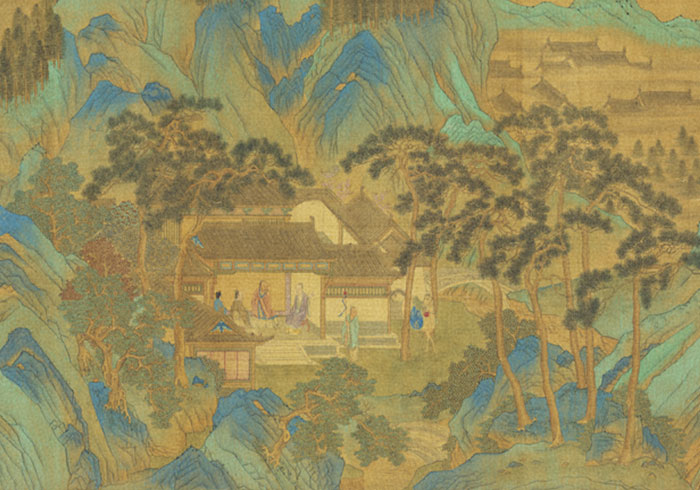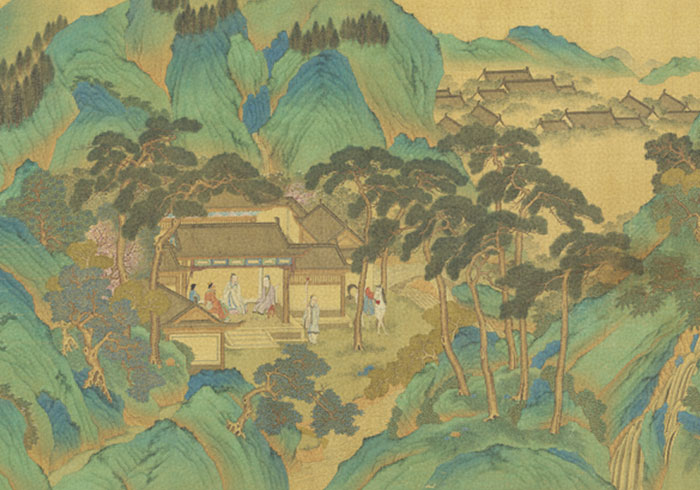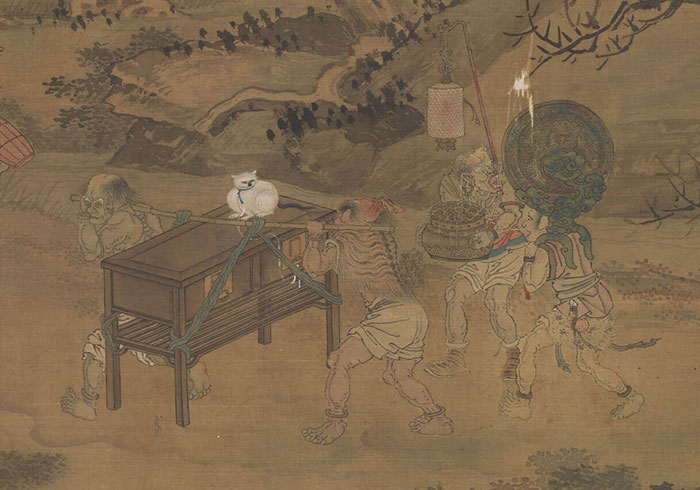The "Suzhou fakes" now in the National Palace Museum were once sought-after products revealing several different styles popular in collecting circles at the time. For example, one type is represented by "Spring Dawn in the Han Palace" and "One Hundred Beauties," works which offer an imaginatively romantic view of life in the ladies quarters of the palace. Suzhou workshops also manufactured narrative paintings based on famous literary works, such as majestic depictions of the imperial hunting grounds at "Shanglin Park" from "Ode on Shanglin Park" by Sima Xiangru (179-118 BCE). Paintings of immortals with obvious messages of long life, such as "Gathering of Immortals Offering Blessings" and "Offerings for Longevity at Gem Pond," were likewise popular along with such didactic and Confucian themes as "Twenty-four Paragons of Filial Piety" and "Explanations on Cultivating Rectitude." The works in this section of the exhibit, with title slips giving the names of masters including Zhou Fang of the Tang dynasty, Zhao Boju of the Song, Wang Yuan of the Yuan, and Qiu Ying of the Ming, often have rich colors of dazzling blue-and-green, feature detailed renderings of decoration on clothing and buildings, and emphasize scenery in the narratives, all of which are qualities reflective of these "Suzhou fakes."
The phenomenon of "multiple versions from a single source" seen among the works in this exhibit illustrates the fact that Suzhou fakes were commercial products made in large quantities. The varied quality of these versions also suggests there may have been price discrepancies on the market, and various themes but with similar styles, inscriptions, and seals and signatures point to the range and subject matter of Suzhou fakes. This part of the exhibition presents a fascinating display of Suzhou fakes divided into two rotations to accommodate all the alluring attraction of these "fineries of forgery."
Noble Sons
- Attributed to Zhou Fang (fl. ca. 780-ca. 810), Tang dynasty
- Handscroll, ink and colors on silk, 39.6 x 327.7 cm
The title of this painting translated literally from the Chinese is "hoofs of lin," referring to a mythical beast and alluding to sons of the ruling family. The handscroll depicts the ladies' quarters of the inner palace, where we see children being bathed and playing. Although the painting certainly does not date back to the Tang dynasty, certain elements, such as the plump ladies and their high-waisted robes, indeed fit the Tang dynasty "Zhou style" as practiced and popular in the Ming dynasty. Such motifs as children bathing and teasing youngsters can likewise be found in other "Suzhou fakes" given to Zhou Fang. Also seen among the figures are those associated with the famous Ming artist Qiu Ying (ca. 1494-1552), such as the lady sitting on a throne chair, which appears in his "Spring Dawn in the Han Palace." Although figures are interspersed in the various scenes, each is individually rendered, this work representing a combination of motifs popular among Suzhou workshops at the time.
Test of Skill on Double Seventh Day
- Attributed to Qiu Ying (ca. 1494-1552), Ming dynasty
- Handscroll, ink on paper, 27.9 x 388.3 cm
On the trunk of a tree at the beginning of this handscroll on the right is a signature and seal impression for Qiu Ying, but the painting actually does not relate to his style. Rather, it more accurately reflects the "baimiao" ink manner of the school related to You Qiu (fl. 16th c.), Qiu Ying's son-in-law.
Torches ablaze in a courtyard setting indicate it is an evening scene as palace ladies at the right are busy preparing food and drink. Appearing before a large screen are imperial concubines engaged in calligraphy, reading, and chatting as well as with a go board and pieces that show how they pass the time. This scene is followed by palace ladies surrounded by concubines in groups carrying items and proceeding to the left. After passing by a scene where women have just appreciated antique bronzes and porcelains, we come to the subject of the painting: palace ladies demonstrating and praying for their needlework skills and making a sacrifice. On the altar table is a figurine offering to the gods in the hope of attaining needlework skills and bearing many sons. As such, the painting is filled with a dizzying array of opulent and complex details. Depicting the various activities on or associated with the Double Seventh Day, the artist sought to provide the viewer with a glimpse of the elegant life among ladies in the inner palace.
Ode on Returning Home
- Attributed to Li Gonglin (ca. 1041-1106), Song dynasty
- Handscroll, ink on paper, 34 x 898.8 cm
In addition to the strong blue and green colors of "Suzhou fakes," many are done in the "baimiao" manner of pure ink lines and washes as well. Most are spuriously attributed to the famous Northern Song literati artist Li Gonglin, with whom it is often associated. In this example, the handscroll is patterned after the contents of the "Ode on Returning Home," the famous prose poem by Tao Yuanming (365-427) and painted by Li Gonglin. Tao appears in this painting ten times section by section, arriving by boat, lingering by a lofty lone pine tree, tending to the fields, composing poetry by a stream, and others. Certain details that appear in the painting are not explicitly mentioned in the poem, such as the dilapidated walls, the chicken roost in the rafters of the thatched roof, and the delicately patterned bronze wine vessels.
At the end of the handscroll are Ming dynasty inscriptions in the name of Shen Du (1357-1434), Jin Dun, Xia Chang (1388-1470), and Wen Zhengming (1470-1559), all of which are fake. The forged seals accompanying them, such as "Yunjian Shen Du" and "Shijiang xueshi zhi zhang," are similar to the ones on the fake Huang Tingjian "Running Script Calligraphy" also seen in this exhibit. Perhaps the two were created by the same workshop or group making forgeries at that time.
Gathering of Immortals Offering Blessings
- Attributed to Qiu Ying (ca. 1494-1552), Ming dynasty
- Hanging scroll, ink and colors on silk, 99 x 148.4 cm
In the lower left corner of this painting is a signature that reads, "Attentively made by Qiu Ying, Shifu." Although spuriously given to this professional master, it is delicately and carefully done, a masterpiece among so-called "Suzhou fakes." The subject probably deals with immortals gathering to proceed to the Great Assembly of the Peaches of Immortality and wish the Queen Mother of the West longevity. Scenes of land, water, and air are layered and juxtaposed in a beautifully complex composition. Deities and beasts of immortality are shown on the terraces of the building demonstrating their supernatural powers. Also on the slope in the lower left is the immortal "Iron-crutch" Li riding with abandon on the mule of another immortal, Zhang Guolao. To the left, the primordial spirit has transformed into a ray emitting from a gourd and ascending to the heavens for an audience with the Grand Supreme Elderly Lord.
In contrast with the simple apparel of the immortals, the architecture and implements in the painting are rendered with great detail and decoration. The cloud-and-dragon patterns are traced with delicate lines of gold, and each red column is painstakingly done with different patterns. Despite the blemishes in painting the figures and animals, they do not distract from the overall quality, suggesting this work may have been an expensive birthday gift.
The Queen Mother's Banquet at Gem Pond
- Attributed to Zhao Boju (?-ca. 1162), Song dynasty
- Handscroll, ink and colors on silk, 33.7 x 401.3 cm
This painting given to the Southern Song artist Zhao Boju depicts King Mu of Zhou proceeding to Gem Pond to visit the goddess known as Queen Mother of the West. It is similar to another Zhao Boju attribution in the National Palace Museum collection, "Lofty Gathering at Gem Pond."
The handscroll begins at the right with sea waves in clouds and mists as King Mu and his retinue wait on the shore for the procession dispatched by the Queen Mother and descending from the heavens above. Proceeding left over a path in high mountains, we come to the immortals' realm at Gem Pond. The forms of blue-and-green mountains vary with green "moss dots" and red blossoms that bejewel the peaks. Tall terraced palatial buildings are built into the mountains in an orderly and majestic manner, and immortals wear colorful clothing with white robes in an eye-catching manner. In the middle section of the scroll, flocks of cranes (associated with immortality) and auspicious clouds appear here and there. And finally the latter part of the scroll features a bridge zigzagging over water as a beautiful deer-drawn carriage carries the Queen Mother of the West, the retinue bearing regalia preceding her in preparation for the meeting with King Mu.
The subject of the immortals' realm at Gem Pond is often seen in the Ming dynasty along with such vernacular literature as Investiture of the Gods. This painting reproduces and illustrates in beautiful detail the ornate expressions found in such texts.
Peach Assembly of Immortals
- Attributed to Qiu Ying (ca. 1494-1552), Ming dynasty
- Handscroll, ink and colors on silk, 40 x 440.5 cm
The first section of this handscroll depicts a group of immortals winding down a mountain path and showing off their spiritual powers as they cross the seas to attend a peach assembly. The immortals are walking on the water, being led by a white turtle, riding a golden carp, together on a plantain leaf, sitting on an immortal's raft or large blossom, and in other forms. The following section depicts immortal attendants and celestial ladies at the orchard of immortality picking ripe peaches being prepared for the Queen Mother of the West in her opulent palace. The last section shows the immortals gathering on a tall terrace for an audience with the Jade Emperor.
At the end of this handscroll on the right is a signature that reads, "Made by Qiu Ying, Shifu." The work is extremely close to another painting, "Gathering of Immortals Assembled for Blessings" attributed to Fang Chunnian of the Southern Song and also in the Museum collection, in terms of the brushstrokes and colors used for the clouds, buildings, mountain forests, trees and rocks. Both were probably made by the same Suzhou workshop that produced paintings related to the Grand Assembly of the Peaches of Immortality. However, the number of scenes involving immortals and buildings varies, perhaps reflecting a pricing mechanism used by the workshops.
-
Hunting at Shanglin Park
- Attributed to an anonymous Yuan dynasty (1279-1368) artist
- Handscroll, ink and colors on silk, 47.5 x 1298.2 cm
-
Shanglin Park
- Attributed to Qiu Ying (ca. 1494-1552), Ming dynasty
- Handscroll, ink and colors on silk, 44.8 x 1208 cm
-
Shanglin Park
- Attributed to Qiu Ying (ca. 1494-1552), Ming dynasty
- Handscroll, ink and colors on silk, 53.5 x 1183.9 cm
According to records, a wealthy man of Kunshan, Zhou Fenglai (1523-1555), commissioned Qiu Ying to paint a long handscroll that came out to be more than fourteen meters long. Based on "Ode on Shanglin Park" by Sima Xiangru (179-118 BCE) of the Western Han, it was done as a present for Zhou's mother on the grand occasion of her eightieth birthday. This painting was thereafter copied in numerous recensions and even attributed to old masters of the Song and Yuan.
"Shanglin Park" can be divided into seven sections, the first showing a lofty discourse between "Sir Vacuous," "Master Improbable," and "Lord No-such." What follows is an expanse of wave-filled waters and then layered peaks that make the setting of a temporary palace amidst the emperor's pleasure park. In the following section, the emperor is shown in a magnificent carriage in a long formal procession, which then turns through the mountains into a hunting scene involving the chase for prey. After reviewing the army, the emperor then appears in the company of ladies in a banquet on a terraced tower before finally sobering up and returning to the palace.
On display in this exhibit are three versions of this subject with a similar composition. Except for the one attributed to a Yuan dynasty artist, the other two give Qiu Ying as the painter and the dates of production as 1538 and 1542. The details and decoration of the three handscrolls hark back to antiquity and make for an interesting comparison, the number of surviving works indicating just how popular the subject was in the past.
Presented Scholar Zhong Moving His Residence
- Attributed to Gong Kai (1222-1307), Yuan dynasty
- Handscroll, ink and colors on silk, 11.1 x 332.6 cm
This handscroll depicts the demon queller of folklore, Zhong Kui, being helped by subjugated demons in moving his home. The demons not only carry a shrine and various furniture, such as a table, they also hold decorative furnishings, including a flower vase with a "ruyi," reed instrument from which hangs a spider, and the God of Literature standing on ingots. Respectively, these three symbolize auspicious expressions of blessing: "As peaceful as you desire," "May noble sons be born one after another," and "Coming in first in the three civil service examinations." The humorous figures falling and bickering make for very interesting scenes, as this kind of work combining entertainment and auspicious meaning was quite popular in the art market at the time.
The style and signature of this painting attributed to Gong Kai are quite different from other accepted works. The contents of the colophons reportedly by Qiu Yuan (1247-1326), Yu Ji (1272-1348), and Zhu Yunming (1460-1526) come from those by Wang Xiaoweng, Sun Yuanchen, and Wang Shi written for "Zhong Kui Traveling" in the collection of the Freer Gallery of Art (Washington, D.C.) and considered an authentic Gong Kai painting. Finally, Zhu Yunming's "Xizhe" seal on the scroll here is similar to that on "Landscape" attributed to Qiu Ying in this exhibit, both probably coming from the same workshop.

